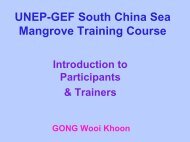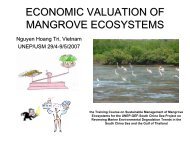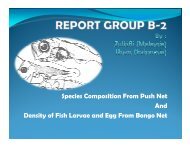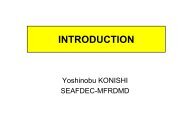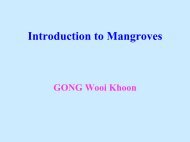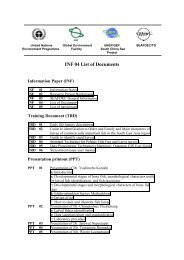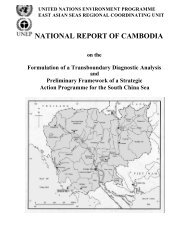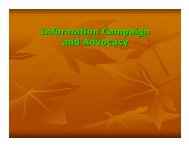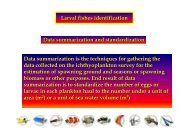Status of Coastal and Marine Ecosystems in Indonesia
Status of Coastal and Marine Ecosystems in Indonesia
Status of Coastal and Marine Ecosystems in Indonesia
You also want an ePaper? Increase the reach of your titles
YUMPU automatically turns print PDFs into web optimized ePapers that Google loves.
The Regional Tra<strong>in</strong><strong>in</strong>g Workshop<br />
Economic Valuation <strong>of</strong> the Goods <strong>and</strong> Services <strong>of</strong> <strong>Coastal</strong> Habitats<br />
March 24 – 28, 2008<br />
Samut Songkram Prov<strong>in</strong>ce, Thail<strong>and</strong><br />
<strong>Coastal</strong> <strong>and</strong> <strong>Mar<strong>in</strong>e</strong> Ecosystem Situation <strong>of</strong> <strong>Indonesia</strong><br />
• Bambang<br />
• Agus<br />
• S<strong>of</strong>i<br />
• Did<strong>in</strong>g<br />
1<br />
• CORAL REEF ECOSYSTEM<br />
• MANGROVE ECOSYSTEM<br />
• LAND BASED POLLUTION
Coral reefs scientists have noted that <strong>Indonesia</strong> is the<br />
center <strong>of</strong> coral diversity. It was reported that 82 genera <strong>and</strong><br />
about 590 species <strong>of</strong> scleract<strong>in</strong>ian corals have been<br />
recorded <strong>in</strong> the <strong>Indonesia</strong>n <strong>and</strong> its surround<strong>in</strong>g waters (Best<br />
et al., 1989; Tomascik et al., 1997; Veron, 2002)<br />
2
3<br />
Coral Diversity
Threat to Coral Reef <strong>in</strong> <strong>Indonesia</strong><br />
The five ma<strong>in</strong> man-made :<br />
• poison fish<strong>in</strong>g,<br />
where cyanide is squirted on coral heads to stun <strong>and</strong> capture live<br />
aquarium <strong>and</strong> food fish, but kill<strong>in</strong>g coral heads <strong>in</strong> the process;<br />
• blast fish<strong>in</strong>g,<br />
whereby small bombs are detonated <strong>in</strong> shallow reef areas, kill<strong>in</strong>g<br />
targeted schools <strong>of</strong> fish, but also kill<strong>in</strong>g larvae, juveniles <strong>and</strong> corals;<br />
• coral m<strong>in</strong><strong>in</strong>g,<br />
where corals are collected <strong>and</strong> smashed for house construction <strong>and</strong><br />
lime-production;<br />
• sedimentation <strong>and</strong> pollution,<br />
as a result <strong>of</strong> logg<strong>in</strong>g, erosion, untreated sewage <strong>and</strong> <strong>in</strong>dustrial<br />
discharges, which smother <strong>and</strong> kill the corals; <strong>and</strong><br />
• overfish<strong>in</strong>g,<br />
which does not destroy corals but reduces abundance <strong>and</strong> diversity<br />
<strong>of</strong> fish<strong>and</strong> <strong>in</strong>vertebrates.<br />
4
current major threat<br />
5
Values & Functions <strong>of</strong> Coral Reef<br />
Types <strong>of</strong> values<br />
Direct use value (extractive)<br />
Direct use value (non-extractive)<br />
Functions<br />
food/other resources (fishery, etc);<br />
construction material; pharmaceuticals<br />
<strong>and</strong> other <strong>in</strong>dustrial chem.<br />
tourism <strong>and</strong> recreation; educational,<br />
scientific <strong>in</strong>terest<br />
Indirect use values<br />
biological support; coastal protection<br />
Indirect Non-use values<br />
fall-back life support; gen. resources;<br />
global heritage; & known <strong>and</strong> unknown<br />
future uses <strong>of</strong> the functions above<br />
Spurgeon (1992)<br />
6
The <strong>Indonesia</strong>n mangrove forests cover at least<br />
4.25 million ha, <strong>and</strong> are concentrated <strong>in</strong> some<br />
biggest isl<strong>and</strong>s. This figure, which based on<br />
estimated <strong>in</strong> 1982.<br />
The latest (1995) <strong>of</strong>ficial MOF estimate <strong>of</strong> 3.5 million ha:<br />
1. Protection forest 424,800 ha (12%),<br />
2. Nature reserve 674,600 ha (19%),<br />
3. Normal production forest 683,600 ha (19%),<br />
4. Limited production forest 372,400 ha (11%),<br />
5. Conversion forest 928,900 ha (26%), <strong>and</strong><br />
6. Forest converted 449,300 ha (13%).<br />
7
current major threat :<br />
• domestic exploitation<br />
• salt production<br />
• rice cultivation<br />
• Aquaculture<br />
• oil pollution<br />
• <strong>in</strong>dustrialization, settlement <strong>and</strong> urbanization<br />
• agriculture pesticides etc.<br />
• weed <strong>in</strong>vasion<br />
• coastal erosion<br />
• perception <strong>of</strong> the public.<br />
Various estimates <strong>of</strong> the total areas <strong>of</strong> mangrove <strong>in</strong> <strong>Indonesia</strong> show that :<br />
• at the best, approximately 513,670 ha <strong>of</strong> mangroves have been lost<br />
between 1982 <strong>and</strong> 1993 or 46,497 ha per year,<br />
• the worst scenario 1. 760,825 ha have been lost dur<strong>in</strong>g the same period,<br />
equivalent to 160,075 ha per year 8
Four families dom<strong>in</strong>ate mangrove forests <strong>in</strong> <strong>Indonesia</strong>:<br />
1. Aviceniaceae (sometime <strong>in</strong>cluded <strong>in</strong> the large family<br />
Verbenaceae),<br />
2. Combretaccae,<br />
3. Rhizophoraccae <strong>and</strong><br />
4. Sonneratiaceae (sometimes <strong>in</strong>cluded <strong>in</strong> the Lythraceae)<br />
The utilization trends <strong>of</strong> mangroves <strong>in</strong> <strong>Indonesia</strong>,<br />
can be classified <strong>in</strong>to 2 group:<br />
1. Susta<strong>in</strong>able uses: traditional uses, recreation <strong>and</strong> wildlife<br />
resource, m<strong>in</strong>or products (alcohol. sugar, tann<strong>in</strong>, honey etc.),<br />
mar<strong>in</strong>e products, graz<strong>in</strong>g <strong>and</strong> timber production.<br />
2. Exploitative uses agriculture, mar<strong>in</strong>e culture salt production,<br />
human settlements, m<strong>in</strong><strong>in</strong>g <strong>and</strong> oil exploitation. Exploitative<br />
uses <strong>of</strong> mangrove forests <strong>in</strong>volve conversion <strong>of</strong> mangrove<br />
areas to other uses result<strong>in</strong>g <strong>in</strong> irreversible changes with<br />
9<br />
change <strong>in</strong> l<strong>and</strong>-use pattern.
AVERAGE VALUES OF MANGROVE<br />
FOREST<br />
No. ITEM US$/Ha<br />
I. Use Value 6.972,97<br />
A. Ekstraktif (direct use): 6.034,90<br />
1 Timber 539,36<br />
2 Fire wood 495,27<br />
3 Medic<strong>in</strong>es 240,96<br />
4 Prawn 2.944,00<br />
5 Crabs 697,79<br />
6 Fish 993,72<br />
7 Nener (bibit ikan) 37,68<br />
8 Charcoal 13,13<br />
9 Eel 41,92<br />
10 Wild life 25,17<br />
11 Shell 5,90<br />
10
AVERAGE VALUES OF MANGROVE<br />
FOREST (cont<strong>in</strong>ue…)<br />
No. Services US$/Ha<br />
B. <strong>in</strong>direct uses 938,07<br />
12 Wave breaks 452,74<br />
13 Natural tourism 58,22<br />
14 Nursery / hatchery ground 270,76<br />
16 Carbon s<strong>in</strong>k 156,35<br />
II. Non use value 1.045,93<br />
17 Option value 96,57<br />
18 Exixtence value 948,93<br />
III. Total Economic Value 8.018,47<br />
11
BORNEO<br />
12
SUMATRA<br />
13
L<strong>and</strong>-based source<br />
<strong>of</strong> Pollution<br />
15
Will<strong>in</strong>gness To Pay for Garbage Management <strong>and</strong>,<br />
L<strong>and</strong> Based Pollution Demonstration Site<br />
Tanjung Riau, Batam<br />
The study at Tanjung Riau Village shows that the community is satisfied with the<br />
exist<strong>in</strong>g garbage management.<br />
They have perception that Improvement Program <strong>of</strong> Garbage Management ga<strong>in</strong><br />
benefit for community <strong>and</strong> environment. Nevertheless, the garbage management has<br />
not been applied properly, due to the lack <strong>of</strong> knowledge regard<strong>in</strong>g the process <strong>of</strong> the<br />
organic <strong>and</strong> <strong>in</strong>organic garbage.<br />
WTP for garbage management is Rp 3,825 <strong>and</strong> Rp 4,320/household/month for<br />
Group A <strong>and</strong> B, respectively. The output shows that household WTP for garbage<br />
management improvement at Tanjung Riau Village is not <strong>in</strong>fluenced by community<br />
education, household <strong>in</strong>come <strong>and</strong> expenditure, both partially as well as multivariably.<br />
16
Will<strong>in</strong>gness To Pay for Sanitation Program,<br />
L<strong>and</strong> Based Pollution Demonstration Site<br />
Tanjung Riau, Batam<br />
The condition <strong>of</strong> sanitation at Tanjung Riau Village is relatively<br />
poor, where only a few numbers <strong>of</strong> houses have <strong>in</strong>-house toilet<br />
equipped with septic tank <strong>and</strong> its usage is very low even though<br />
Group A had taken part <strong>in</strong> Improvement <strong>of</strong> Sanitation<br />
Management Program.<br />
WTP for sanitation management is Rp 9,383 <strong>and</strong> Rp<br />
8,239/household/month for Group A <strong>and</strong> B, respectively. The<br />
output shows that household WTP for sanitation management<br />
improvement at Tanjung Riau Village is not <strong>in</strong>fluenced by<br />
community education, household <strong>in</strong>come <strong>and</strong> expenditure, both<br />
partially as well as multivariably.<br />
17




